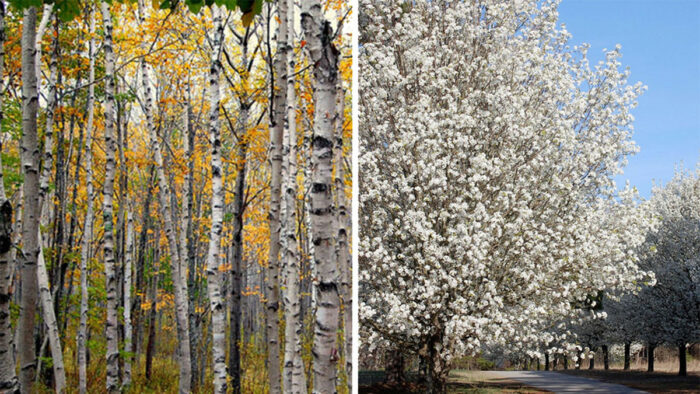
Many trees take decades to reach full size, and in this fast-paced world, not everyone has the patience to wait that long. Fortunately for the eager gardener, there are species that mature relatively quickly, and in the September/October 2012 issue of Fine Gardening (#147), North Carolina Master Gardener Linda Brandon shares 11 of her favorite fast-growing trees for impatient gardeners.
Some trees that grow quickly should be avoided, however, because of weak wood, numerous pests and diseases, invasive roots, a short life span, or other undesirable qualities. Here is her “dirty dozen”:
Leyland Cypress (x Cupressocyparis leylandii)
Zone: 6 to 10
This tree has so many negative characteristics, its success is truly a testament to the nursery industry’s marketing efforts. Granted, it grows very rapidly, eventually reaching a height of 70 feet or so. However, with a life expectancy of only 25-35 years, it essentially starts to decline just as it’s reaching its full height, and it is susceptible to a host of insect and disease problems. Bagworms are a major issue, requiring either hand-picking or spraying with an insecticide-and either hand-picking or spraying a 50-foot tall tree is a major (and expensive!) undertaking.
Diseases affecting Leyland cypress include seiridium canker, botryosphaeria canker, cercospora needle blight, and a variety of root diseases. And think about it: Does your home landscape really need a hedge the height of a five-story office building? Compounding the problem is the fact that people often plant large numbers of these trees as monoculture screens, which means that whatever affects one plant will likely affect all of them. To add insult to injury, some salespeople cheerfully suggest planting these trees twice as close together as they should be planted, saying, “You can always take out every other tree when they get crowded,” and you have a recipe for disaster. This is the source of the largest number of tree problem calls to our Extension Master Gardener Volunteer office Information Line.
Bradford Pear (Pyrus calleryana ‘Bradford’)
Zone: 5 to 9
Bradford pear is the source of the second largest number of problem calls. This is a lovely tree: the spring bloom display is breathtaking, the overall shape is exceptionally symmetrical, and the fall color is glorious. It grows rapidly to 30-50 feet, with a spread of 20-35 feet, and it tolerates a range of soil conditions. Unfortunately, its branching structure leads to large branches or whole sections of the tree simply splitting away from the trunk during winds or ice/snow events. At that point, its highly symmetrical profile is no longer even remotely symmetrical; since they’re often planted in matched sets lining a driveway, the beauty of the entire planting is irrevocably damaged. They are also, unfortunately, an invasive plant in many areas of the country. To top things off, Bradford pears have a fifteen-year life expectancy-essentially making them “disposable” trees. Avoid at all costs.
Walnut (Juglans nigra)
Zone: 4 to 9
Black walnut is a beautiful tree, reaching a height of 75-100 feet, with a spread to match. It tolerates drought and rabbits, provides edible fruit, and makes a lovely shade tree. Unfortunately, its roots produce chemicals called juglones, which are highly toxic to a wide range of desirable landscape plants (azaleas, rhododendrons, blueberries, peonies. tomatoes, peppers, and potatoes). Additionally, the husks of the nuts can stain clothing and sidewalks, so unless you have a really large landscape that will allow you to give this tree its own space, you’d do well to stay away from black walnut.
White Mulberry and Red Mulberry (Morus alba, Morus rubra)
Zone: 4 to 8
Growing to 35-50 feet, with a spread of 35-40 feet, these are attractive, easily grown trees with interesting foliage and edible fruit. Their fruit is very attractive to birds, they tolerate a variety of growing conditions, and they naturalize well (and are, in fact, native to much of the country). However, both of these trees have weak wood and very weedy seedlings; white mulberry is invasive through much of the country, while the fruit of the red mulberry is very messy and will stain clothing and patios. Borers, whiteflies, bacterial blight, coral spot canker, bacterial leaf scorch, powdery mildew, root rot, and witches broom are a few of the other problems that can affect the trees, along with scale, mites, and mealy bugs. All in all, best to give this one a wide berth.
Sycamore (Platanus occidentalis)
Zone: 4 to 9
Sycamore can be a magnificent specimen, growing 75-100 feet tall and wide, with a trunk diameter easily reaching 8 feet, characterized by mottled, exfoliating bark. Sadly, it is prey to sycamore anthracnose, a significant disease that can severely damage the tree. Canker, leaf spot, powdery mildew, borers, scale, Japanese beetles, caterpillars, and mites all afflict sycamores. More important to homeowners, though, is the fact that litter from the leaves, twigs, bark, and fruiting balls pose significant problems in terms of maintaining a neat landscape. With so many marvelous trees available that don’t have these problems, why invest in this one?
White Pine (Pinus strobus)
Zone: 3 to 8
White pine is a moderate-sized tree, reaching a height of 30 to 40 feet and a spread of 7-10 feet. Unfortunately, it is affected by white pine decline, which causes needle discoloration and browning, shriveled bark, oozing sap, and, in some cases, death. It’s also vulnerable to injury from salt spray, ice damage, and winter burn, and it’s susceptible to ozone damage, an increasing threat in urban/suburban areas. White pine is also much loved by bagworms and yellow-bellied sapsuckers. Again, why plant a tree that you know is prone to this many problems?
Birch (Betula spp.)
Zone: 4 to 9
Several varieties of birch are lovely landscape plants; a few sport dramatic exfoliating bark. In addition, many thrive in wet environments; avoid planting in a hot, dry location, and aim for afternoon shade. Generally reaching 40-50 feet, occasionally available as a clumping tree with 3-5 stems, birches, particularly river birch (Betula nigra), are popular landscape plants. Many birch varieties are susceptible, though, to the bronze birch borer, a tree killer, and they have a very shallow root system that can be easily damaged by soil disturbance. Birch leaf miner is another significant problem, and control requires spraying, which is time-consuming and costly. Not a tree to be avoided at all costs, but think carefully before planting.
Lombardy poplar (Populus nigra)
Zone: 3 to 9
Avoid this tree at all costs. Characterized by a very tight columnar shape, the Lombardy Poplar can exceed 100 feet in height within 20 to 30 years. However, at that point, it’s also reached the end of its life expectancy, so it’s another “disposable” tree as opposed to a permanent landscape addition. Lombardy poplars have structurally weak branches that break easily when stressed by wind, snow, or ice. Leaves and branches shed, causing sanitation issues in a home landscape. Roots can invade sidewalks and damaged sewer lines. There are few redeeming characteristics other than its rapid growth rate. Save your money and invest elsewhere.
Norway Maple (Acer platanoides)
Zone: 3 to 7
An easily grown tree, Norway maple will reach 40 to 50 feet in height with an almost equal spread, and it tolerates air pollution and drought quite nicely. It has a few problems (verticillium wilt, which can be fatal, as well as sunscald and cracking of the bark), but the a more significant issue is its thick leaf canopy and shallow root system that severely limit what can be planted within the tree’s drip line. Combine that with the fact that Norway maple is considered invasive in ever-widening areas of the country, and it adds up to another tree to avoid.
Empress Tree (Paulownia tomentosa)
Zone: 3 to 8
Native to Central and Western China, the “royal empress tree” (it’s marketed under a variety of names) bears strikingly large leaves and showy, fragrant flowers on a frame that grows 30-40 feet tall and wide. Unfortunately, its wood is weak and subject to breaking, and the tree, marketed as “easily propagated,” is so easily propagated that it’s become invasive in much of the eastern half of the country. We don’t need more of these planted; they’re spreading quite nicely on their own without our assistance.
Mountain Ash (Sorbus americana)
Zone: 3 to 7
A lovely tree that will grow to around 30 feet, with a spread of perhaps 15 feet, the mountain ash is a good food source for a variety of wildlife. That’s all good, but the list of potential problems includes borers, aphids, sawflies, scale, mites, fire blight, rust, and scab. Cankers, crown gall, and powdery mildew may also attack. Seriously now: do you want a tree with this many potential problems in your landscape?
Mimosa Tree (Albizia julibrissin)
Zone: 6 to 9
Native to Iran and Japan, the mimosa tree is a lovely, delicate-looking tree with fern-like foliage and showy, powder-puff-like pink blooms. It tolerates high temperatures and a wide range of soils, including high alkalinity. It grows rapidly to 20-40 feet, with a striking vase shape that makes it a lovely accent tree for a home landscape. Those are all strong positive attributes, but the Mimosa is susceptible to a serious wilt problem, as well as mimosa web worm. More significant to homeowners, though, is the fact that it is a prolific self-seeder, so you rarely have “just one” Mimosa. The wood is weak, and is often damaged in storms. To top it all off, most folks plant it near the house so they can enjoy its lovely flowers from a patio, and as the blooms fall, they (and the leaves and seed pods) drop onto the patio, where they become a significant housekeeping issue. Best to enjoy this plant in someone else’s landscape.
Austree (hybrid between Hankow willow [Salix matsudana] and white willow [Salix alba])
Zone: 2 to 9
If you’re looking for a temporary windbreak or an erosion control solution, this could be your tree. It will never be a suitable shade tree, thought, and experts recommend planting it-if at all-along with more “permanent” trees if you’re using it in a windbreak or screening application. The hybrid Austree will, indeed, grow up to 10 feet annually in moist sites, reaching a height of 35-45 feet and up to 30 feet in width. “Live fast, die young,” though, applies to the Austree. Like most fast-growing trees, it has extremely weak wood that is very susceptible to storm damage, and it drops leaves and small branches non-stop. Add to that its susceptibility to disease and insect problems, and you have a tree with very limited application and desirability.
Photos: commons.wikimedia.org


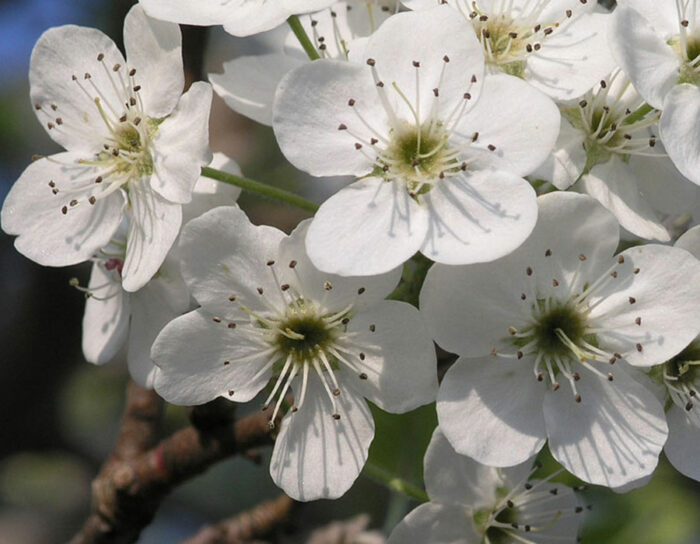

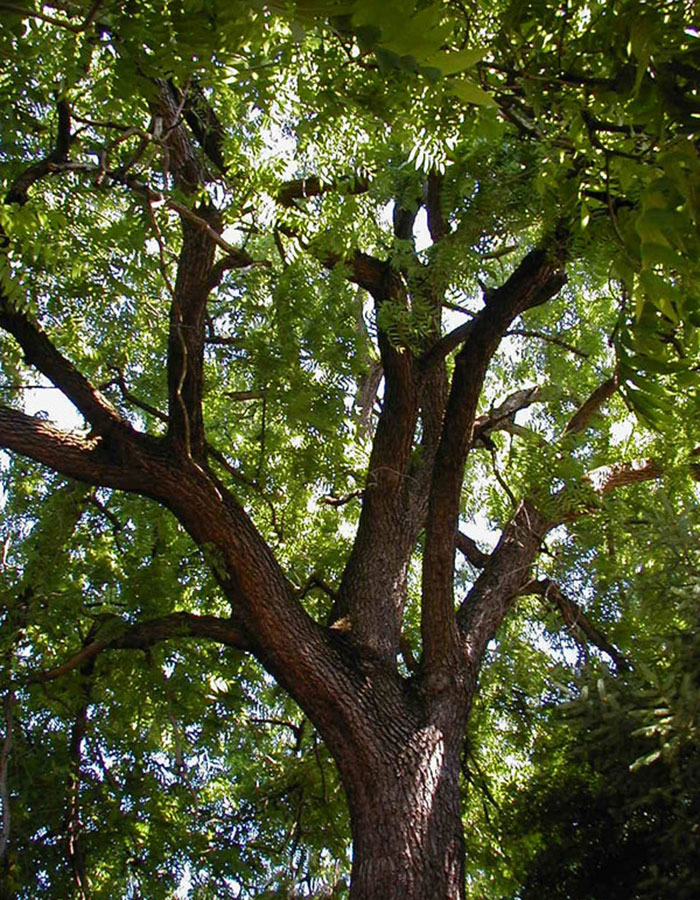
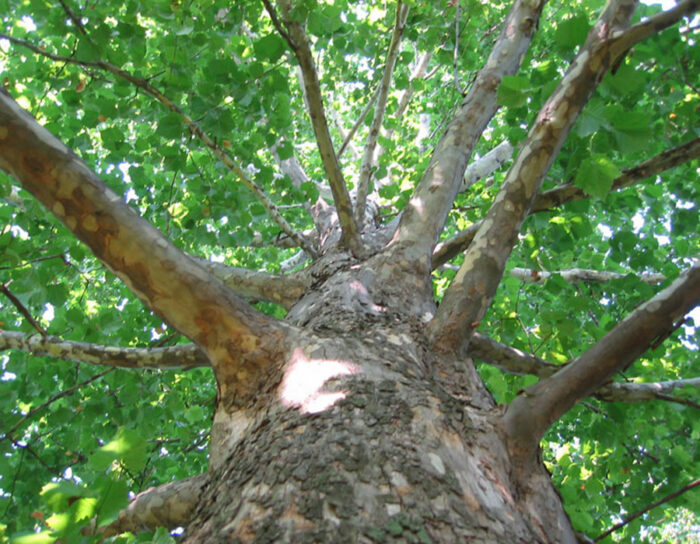
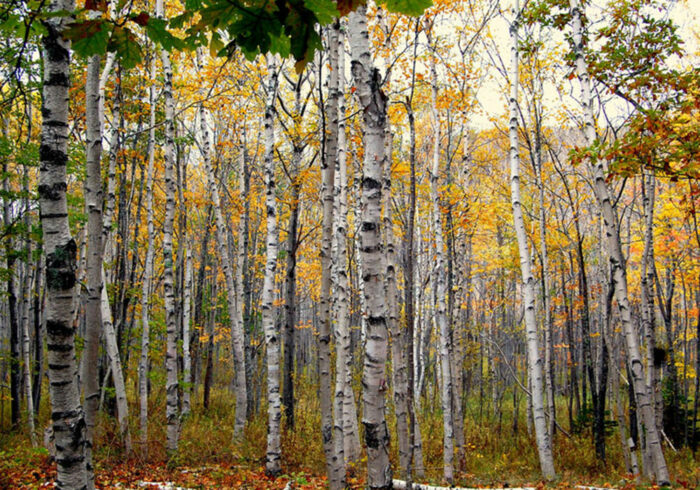
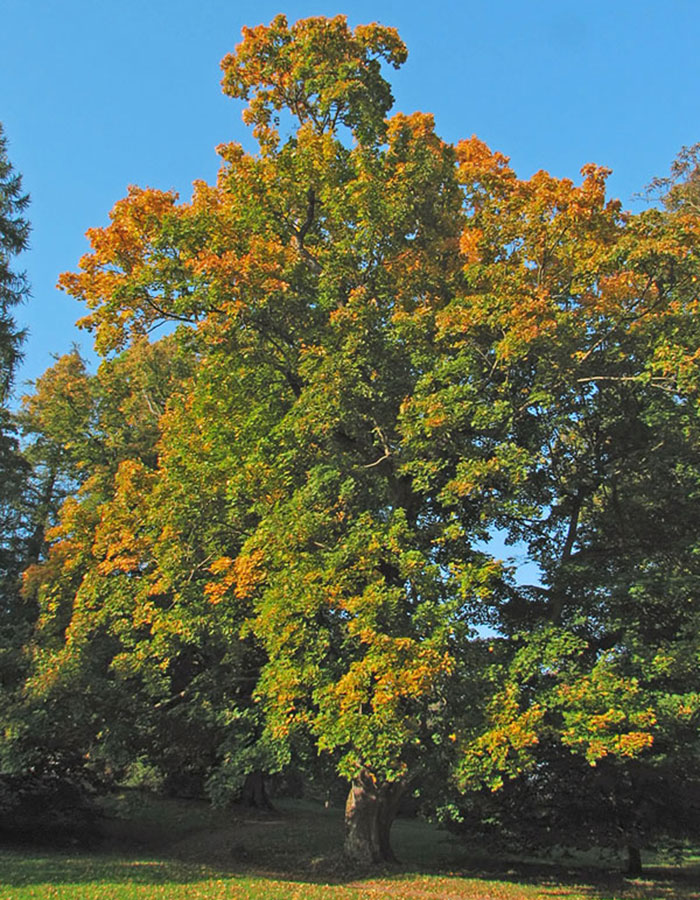
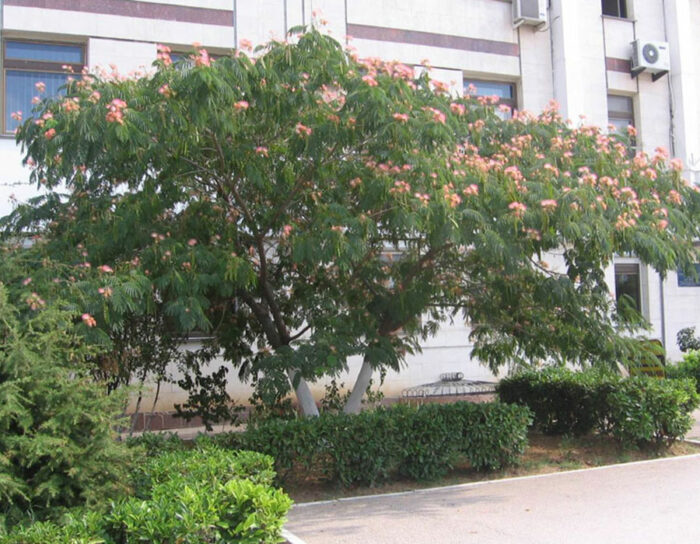
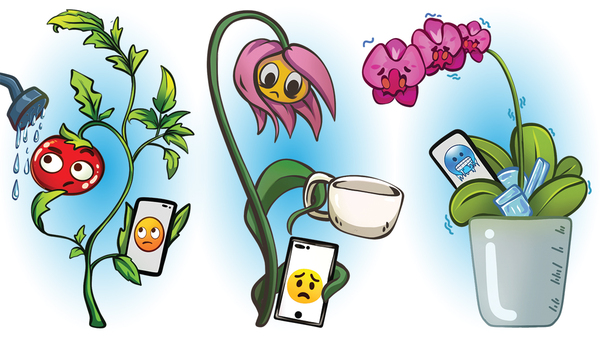
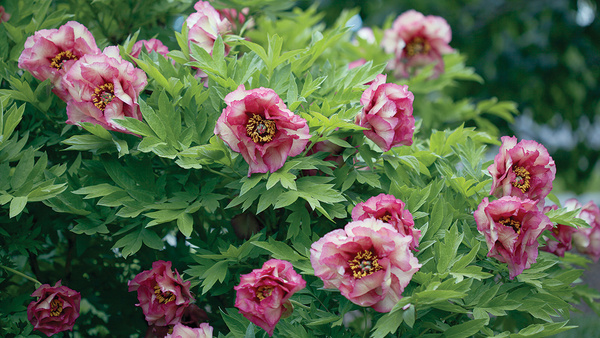














Comments
This is helpful and would be even better if substitutes trees were suggested for the ones to be avoided.
Thanks, Betty
I would add Silver Maple to the list. It grows very fast, becomes very tall, develops into a stiff, ungraceful form, has a wide-ranging, shallow root system and is prone to storm damage. Yes, the leaves are pretty, but that's about it.
Could not agree more with this list of trees! Would love a follow up on the best shade and ornamental trees to plant and enjoy!
I would concur with the need to avoid silver maple. In drought conditions the shallow root system means it is one of the first trees to succumb without supplemental watering.
Thanks for the detailed information on why these trees are best to avoid in the home yard. I still curse the old maple that fell in the front of my house a week after I moved in. Every time I dig a hole there is another large dead root staring at me...
I would like to add to the requests for suggestions of alternatives for each of these fast growing trees!
When we moved into our present home five years ago, we inherited a fully mature black walnut. It's been there for years and is one of two known on Nantucket. While it is lovely and provides lovely dappled light for our dining patio, it is a nuissance! Twelve months of the year this tree drops a mess all over the place and heavy nut bearing years bring in masses of squirrels. It is a constant chore keeping our patio clean! That's just the easy part! When we moved in the lawn was failing. We redid it. It didn't do that well. I put in perennial beds to compliment the beautiful hardscaping and structural planting that the former owner had hired a well-known designer to do. Some plants didn't do well, inexplicably. So, I began to do some research. The juglones emitted had hit the lawn hard. I began spreading Jonathan Greens "Black Beauty Ultra" as an overseed in late May through early June this year. The resulting lawn is lovely! I will overseed again when the weather is less humid but still warm. There is a slight incline from the tree to a part of the back of the property. The failing flowers had been wiped out by the juglones. Now that I know what's going on, I can work around it. What amazes me is that the walnuts dropping into the koi pond don't kill the fish. That was what led me to the research. A bucket of water left beside the pond one night contained pitch black water the next day...2 or 3 walnuts had dropped from the tree during the night.All in all, I would say that the juglans nigra is a beautiful tree but needs to be, as stated, in a big landscape and not uphill of any gardens. The juglones are known to have effect as far as 80 feet from the tree and, I suspect, a downhill pitch would extend that on the down hill side.
As for the pear I planted....I hope it's not a Bradford. Got to check on that!
Great article! I have 3 black walnut trees along the narrow strip between my house and my neighbors. They are a big problem! My neighbor and I have lost landscaping plants and produce plants in attempt to get something to grow near them. The walnuts get caught in my gutters and they stain the patios. To have them removed would be quite costly as our village requires a permit to remove trees. Who put these here?!
Since when to White Pines top out at 40 feet? It is not uncommon for these trees to reach 100 - 120 feet in the Northeast and they are one of the top value logging trees.
They are very susceptible to storm damage, so the should not be planted close to a house.
Leyland Cypress - Some 6 years ago I needed to chose a fast growing tree to screen a 4 storey house built during the summer in 4 days with factory fabricated sections next to my mainly 1 story house with only a bonus room above the garage. The Forsyth County Extension office provided a list of suitable trees and Leyland Cypress was top of the list. I could protest the 40 ft + house but I was told they had lots of kids so I took the friendly option and planted a single row of Leyland Cypress.
A year later after 2 years on the waiting list I was accepted into the Master Gardener course and several lectures at some point really bashed Layland Cypress and Bradford Pear, so finally I asked the Extension Agent giving the lecture why his comments were in direct conflict with a Forsyth County Extension published document. Seems they still had a stock of an old document that had not been withdrawn from circulation with the main originator froths document deceased. I follow Georgia Tech and NC State doc,s on care of the trees with mainly feeding of roots with Triple Phosphate and cutting of surface roots to encourage deep roots and spring treat for other problems, so far no problem
Thank you for the information , very important know this things. There are any suggestions ' I need privacy from the house near mine and i have a very big fence with :- Leyland Cypress (x Cupressocyparis leylandii and they have 20 years. They are not very nice this year .
I live in portugal , my land is very dry , the weather hot , long summers , no rain etc.
Thank you very much. I need do something ....
anaabrantes157
Ruth, thanks for identifying these trees, however, you missed a 13th tree. It is commonly called "Baby Twisty" and "Twisted Baby." I would place it at at the top of the list. I believe it is part of the black locust family of trees. I am currently in the middle of a nightmare with this tree. It was a gift about 20 years ago and it keeps on giving hundreds of new sprouts. It was fine until about five years ago when the sprouts began popping up in the lawn from suckers. Last year I finally removed it, applied chemical treatment to the cambium layer of the stump and had it ground out this year but new trees keep coming up from suckers that extend up to 50 feet from where the tree was planted. I found out there are basically two ways of controlling the sprouts -- Start over by tearing out the entire root system or treating each sprout by cutting it down to a stump and applying a chemical like Ortho's Poison Ivy and Brush Killer full strength and keeping at it as new sprouts come up. I've done this to hundreds of sprouts. What a nightmare!
Add Tree of Heaven to that list. Pretty tree, but unlike walnut and silver maple, it appears that nothing eats the seeds, so hundreds of little seedlings must be picked. Those seedlings all have a nasty odor, and the trees poison wells. We should have left that one in China.
Good article --- But what about the Tree of Heaven (or hell) Alianthus altissima the Tree that grows in Brooklyn and almost anywhere else. I currently battle this pest. An oriental invader of the worse sort.
I planted over a half dozen Improved Bradford Pears 12 yrs ago and have been very pleased with them. Is the Improved Bradford stronger??
Another tree to avoid is the Chinese Tallow Tree aka Popcorn tree. I love the decorative white seed clumps, but each seed will grow a new tree. Some have gotten to the banks of our pond, so I am constantly on the lookout for new babies.
Add the green ash tree to your list if you live in the MidWest. The emerald ash bore has infected all four of the green ashes in my yard. I've been able to "save" two of the trees, but now face removal of two of these trees. Unfortunately, many of my neighbors haven't treated their trees so it is a constant battle against this nastly little invader.
Unfortunately the author didn't suggest alternatives.
Instead of American sycamore grow London planetree, they are not prone to athracnose. Just be sure to give them plenty of space, they become huge... they also do very well in moderately wet areas (near waterways). Sycamore should not be planted within a 100' of a structure... no large tree should be planted were it to fall it can reach your house, barn, your neighbor's structures.
Instead of bradford pear grow redspire pear, I think they are more spectacular.
For excellent screening plant Canadian hemlock.
Instead of leyland cypress try dawn redwood, a gorgeous specimen tree.
Instead of birch plant paperbark maple (Acer griseum), you'll fall in love.
London plane tree is fine but its cream and khaki splotched bark misses the drama of the stark white and tobacco colors of the American sycamore. That said the best advice I've ever heard is don't plant the American sycamore but don't cut it down if you find one, Enjoy its beauty.
Hemlock is not a good idea - they succumb quickly to an infestation of wooly adelgids.
In place of the stark white Betula edulis plant River birch. They are messy, but do give that birch effect.
I second the addition of Tree of Heaven (Ailanthus altissima) to this list for sure. It is highly invasive in many parts of the country, including here in the Pacific Northwest. My neighbor has a mature female tree and I spend all year pulling hundreds of stinky saplings out of my beds. http://en.wikipedia.org/wiki/Ailanthus_altissima
I would add privet to your list. They drop those berries, and you have thousands of babies with very deep roots--hard to pull out if you let them get over an inch or two.
Fortunately, ailanthus altissima is illegal in most states for very good reason. Here in the Shenandoah Valley, it's one of the most highly invasive species in the area, and foresters are fighting an uphill battle to eradicate it. (That horrible rotting-peanut smell is an herbicide it produces to inhibit competition, killing off many native species) I doubt anyone will willingly plant them when they're not available on the market, and there are already entire swaths of land with nothing but this tree.
On the other hand, albizia julibrissin are also illegal in several southeast states, not nearly as invasive but they can be problematic. (At the very least, though, hummingbirds love them, which is more than I can say for the tree-of-heaven)
This is a valuable article, but I agree with posters that Ailanthus and Ash should be added. In the northeast, another tree to avoid would be hemlock - the hemlock wooly adelgid is killing 80% of the trees. Hemleck is the most numerous species on my 35 acres, so I'm more than a little concerned.
Some other things to think about - if you are removing a black walnut tree, please remember that it has the most valuable wood of any hardwood growing in the northeast. Consider selling the wood and bargin to have the limbs & stump removed as part of the deal.
White pine can get very tall - yes well over 100 feet. Also, my biggest problem with white pine here in Pennsylvania is that unless it is grown in the shade, bud "worms" kill the terminal shoot every few years.
Sycamore is one of my favorite trees - sorry, but I'll live with its "problems."
Some of these other trees, such as Lombardy poplar, can be planted and grown with intelligence. Plant a row of trees, say 2 Lombardy poplars planted between sugar maples. The poplars grow fast, but provide a quick screen or windbreak. Cut down the poplars when they start to crowd out the sugar maples.
Yes thank you for the list... please do give us a list of desirable trees.
I have gardened or observed locally many of the no-no trees and was thinking seriously of a sycamore. There is a giant old one in a neighboring town and it is much beloved and apparently healthy, and I have observed it for 50 years, since I moved to the area as a young person. There is also one in my town that I pass every time I go grocery shopping, and while it appears fairly youthful, it looks healthy. Since I live in a New England tree monoculture - maples rule here! - I want a tree that will give good shade and will not take forever to be useful and also beautiful. I have three beautiful sycamores at a distance from the house, but they drop seeds that create seedlings, and only the lawn mower will eradicate them. I was thinking of a tulip tree, which is reasonably fast growing I believe and very beautiful when not grown in a forest setting. And yes it does drop flowers in the spring but the one I am best acquainted with is strong and healthy and shade plants grow closely all around it. It was not the list, so I remain hopeful that it might be a good choice. Anyone care to comment?
Just had the Bradford Pear drop it's very large bottom branch onto the driveway (planted by the contractor about twenty years ago)four days ago. Covering the cars - no major damage - and at the front entrance to my 'cat house' - that is the single car garage side of the three car garage where I have multiple cats living. I was sure there were several squashed cats underneath the large, deep mass of limbs and leaves - there wasn't.
All this drama happened in the middle of the night when there was no storm or winds occurring and I had just cleaned up the area to look prettier than the inside of the house!
Now waiting for the neighborhood tree company to catch up to me to remove that whole tree, or what's left of it, plus it's twin on the other side of the driveway, even though the draping effect was lovely over top.
You nailed it!
How is it that no one has mentioned sweet gums? They grow fasy and are great shade trees but the fruit could be used as a lethal weapon in the hands of one so inclined! Stepping on them in your bare feet will make anyone swear like a sailor! And, the fruit drop all year long. A truly horrid tree!
So what trees do we plant??
I would like to point out that many of our native trees provide valuable wildlife habitat. What we might think of as pests or a mess plays an important role in the balance of our ecosystem. As more and more habitat is destroyed, I believe gardeners and landscape designers can offer a happy medium by educating themselves and making more responsible choices. A good online article to read (and online resource) if you are interested in learning more: http://www.ecosystemgardening.com/top-10-best-woody-plants-in-conservation-gardening.html. A book that changed the way I garden: Douglas Tallamy's Bringing Nature Home. Here in my area of the country (Northern NY) the NY Botanical Garden offers a planting guide entitled Native Alternatives to Invasive Plants. I planted a White Pine and a River Birch which supports 411 species including the beautiful Luna Moth, and is at very low risk of being infected by the birch borer. I hope this was not a mistake but I do have many birds and much wildlife to enjoy which adds to my garden and landscape.
Live in NJ zone 6A and have great success with linden and weeping linden; summer fragrance (but does draw honey bees); no pests, nice shape. not big trees.
re: alianthus - terrible invasive. have found combination of roundup and trichlor effective but it takes repeat application.
It is hard to imagine having mulberry on the same list as Bradford Pear. We have a giant Red Mulberry in our back yard at Happy Acres and yes, the seedlings are a nuisance but the native tree is much loved by birds, and while they are busy eating mulberries they are not eating our blueberries and cherries.
The Bradford pear on the other hand is a scourge I would not wish on anyone. I maintain that anyone who plants a Bradford pear should be required to be around years later with a chainsaw to help clean up after it when it has wind or ice damage.
Thevioletfern makes great points about the role of native trees in our backyard habitats. We would be better off giving natives a chance instead of planting 'more desirable' non-native species that might be delightful to look at, but totally foreign and inhospitable to our native insects and birds. We have some of those in our backyard as well, no doubted planted by the same former owners who planted the Bradford Pears.
I agree with Betty, I'd love an article on the 12 (or more) best trees. This was a great article as I'm in the market for a tree and a couple of those were on the "possible" list.
Dawn
I had to laugh at the reasons given for not planting some trees---"do not plant mulberry as the berries will stain clothing and patios", "do not plant white pine because bagworms and sapsuckers like them". So if you are lazy and don't want to clean off your patio, do not plant trees. My sister has had a mimosa tree for a quarter of a century and has never had any type of problem with any wilt or storm damage. "Don't plant white pine because there is a virus attacking them". I notice they did not advise not to plant ash trees because of emerald ash borers.
So people, get rid of all your trees. There is something wrong with all of them!!!
LOL!!!! I totally agree with you.
I can't believe the reasons for not growing most of these American trees. I wish I could grow a hundred Walnuts, or Sycamores, or ?--well I've already got many Mulberries growing here, and I'll keep them. They provide me with fabulous jelly!(if the birds don't get the berries first)
The author should check some facts before writing the next article. White pine stopping at 30-40 feet would be a surprise to a lot of the examples at 5 times that height. I wonder how the early pine furniture makers managed to get pine boards 3 feet wide from such a tree.
Back in those days there was many more mature trees around.
There is a man who found a sunken ship with a load of this old growth.
He is making a fortune bringing it up to be used for furniture.
Birds eye maple isn't around now days that large.
If you like a tree that sheds its bark all year round in large pieces that crush any plants you may have around them, then get a Sycamore. The builder for our development planted them as curb trees, I have 2, they are horrible, unattractive, messy trees. This year they are dropping their leaves now, in July. I think they have some sort of disease. Not just my 2, every single one on my block is doing the same thing. Wish I could have them removed. There are so many nice native trees, I don't know why they planted these things. I would rather have scrub oak trees than these.
Yeah to 'thevioletfern"! Native plants and trees are critical to the preservation of our wildlife. Become aware of the potential 'problems' some natives may develop and plant them strategically. The benefits of planting native plants far outweigh the negatives.
Reading Douglas Tallemy's "Bringing Nature Home" will provide the reader with a plethora of information on planting natives.
I like to use native trees. I'm not dogmatic though. I've got thirty years experience growing growing certain species and I think what it takes is to first respect and acknowledge the site where the trees grows. Then pay attention to the resources you can and will dedicate to growing the tree. For me the most important resource is my time. I made my living growing maple. Right now I'm in the middle of a friggin desert, and my "forest" consist of three maples that I overtend for sentimental reasons.
They require two prunings per year, and careful monitoring of water conditions. The pruning has to anticipate 100 year storm conditions {December 1st - 4 hours sustained 70 mph winds, followed next day by 45 mph winds from 120 degree different direction - I lost no branches - NONE!}
If you try to grow a loblolly pine on the Georgia / South Carolina line and do not tend it by research, consultation, monitoring, and thoughtful response to changing conditions you will be worse off than the fool who tries to grow Sugar maple on the high desert but monitors the trees daily, researches by observation and continued monitoring the scientific info - and is driven by heart. {To be clear that fool is me}.
Your article was correct, however our mimosa is so shockingly beautiful that I will put up with its negatives.
I agree that a better article would be trees to plant. I have a beautiful walnut tree in my backyard. It is probably over 100 years old and I would not trade it in for anything. And yes I have found plants that will grow around it. It provides wonderful shade and was around before any people came to the area. I also have a Norway Maple that is very old and I hope lasts for another 100 years. I also have a birch tree that experts told me years ago would not make it and yet 15 years later it is still thriving. So much for the experts!!!!
About recommendations for good fast growing trees: The introduction to this list says: "September/October 2012 issue of Fine Gardening (#147), North Carolina Master Gardener Linda Brandon shares 11 of her favorite fast-growing trees for impatient gardeners." So I guess that would be the substitutes for the problem trees.
As Ruth points out in the beginning of the post, the list of desirable fast-growing trees is in the current issue of Fine Gardening.
As a landscape architect I would add a few including willow ,some eucalyptus and privet, remove a few and possibly clarify where these trees can be planted. Nearly all trees, and plants for that matter have there rightful place in the landscape. Some trees on this list are not intended for residential landscapes with medium to small yards but do well in park environments. Click on Ruth link, great articles and as always we should all be happy that Fine Gardening is in our lives.
1st of month glitches...website said not responding and then somehow comments posted twice.
Happy Gardening!!!!
I have several huge 100 plus year old sycamores in my yard that are a blessing and a curse. One is way too close to the house and will some day be an expensive removal issue. Aside from seed balls clogging the gutters;dinnerplate sized (but compostable) leaves:the back sides looking like an entomology lesson;twigs and bark flakes everywhere ALL the time,laughing at leaf blowers and the humans wielding them; and the not-so-rare thigh sized fallen branches...I LOVE these trees. For being so mottled at the bottom, the upper branches are amazingly white. Sunset turns these upper reaches into gold pink purple glory. A rainy day impossibly ramps up the colors. Add a tumbling sky as a backdrop and you have living Currier & Ives. And a full moon in the dead of winter is beyond description. There are no bad plants, just plants in the wrong places.
Or, too many people ignorantly destroying their habitats. Our neighbor across the street cut down all the trees in his front yard over the years (we live in a wooded, mountainous neighborhood) because he was obsessive about keeping leaves off his lawn. Too many people seem to equate a perfect lawn with personal success in life and I think it's very sad. For them, and for all the native plants and creatures that get mowed, poisoned or starved as a result.
20+ years ago, we cut down a Black Walnut tree. We did have some azaleas growing around it, but they were small. To this day, they are still very small - the ones that haven't died. It would seem juglones persist in the soil for many years.
I always have a tough time with these sorts of lists as they can be quite reductive and are not always particularly comprehensive. For example, nowhere on this list do I find Tree of Heaven (Ailanthus altissima), the scourge of urban forests across the country, a fast-growing, weak-wooded tree that raises the bar on "invasiveness". In Detroit, a non-profit has recently begun to harvest these trees and use the wood for frames and other salable items; the tree's promiscuity alone suggests this could be a long-term enterprise.
The recommendation to not plant native plants (in this case, trees), always raises and alarm for me, as these plants are critical to the ongoing health of the local food web (including desirable insects, birds and other life forms). Therefore, just as there are numerous desirable landscape plants that cannot tolerate the juglone in black walnut root systems (cutting the tree down will not change the situation any time soon because the chemical remains in the soil at least as long as the root system is decaying), there are just as many that evolved with the black walnut and tolerate the chemical; there are lists easily available on the Internet and at local garden centers and nurseries (not big box stores). As for the sycamore, if you live anywhere prone to winter ice storms or high winds, it is worth knowing that the native sycamore has optimal branching angles, making it the least likely tree to succumb to storm damage.
I don't dispute the information in the above lists, but I would like to bring a different perspective.
I am a furniture maker and when I see White Pine, Birch and Black Walnut I see beautiful and valuable wood. We often don't see the plants in our landscaping as assets, but hardwoods can be exactly that.
A mature Black Walnut tree has the potential to be worth several thousands of dollars to the owner when it is ready to be harvested as timber. Black Walnut is a prize native hardwood among those in the woodworking community and can command 4+ dollars a board foot even in areas of the country where Black Walnut are commonplace. And given current scarcity and demand for Black Walnut I believe it will command high prices into the future as well.
I grew up in the country with a lawn over an acre and a half on which were easily a dozen Black Walnut trees ranging from 100 years old to maybe 30 years old. They did not hinder the grass from growing at all. I think our soil conditions may have had something to do with that. Our soil here in MI is sandy and rich and I believe that helped the roots go deep, away from the surface.
Mind you, we did have several lilac bushes planted between two walnuts that deteriorated over the years as they grew. Furthermore, they were well away from the house. So yes I do echo the sentiment that they are an excellent tree...if you have property to put them well away from the house and more sensitive landscaping.
And we all know that there is no such thing as a maintenance free landscape.
Happy gardening!
mimiphown [url=http://www.casquebeatsbeatspaschere.com/]Casque Beats
[/url] enlimandeme [url=http://www.casquebeatsbeatspaschere.com/]Beats By Dre
[/url] enlimandeme
mimiphown [url=http://www.longchampsaclongchamps.com/]Longchamp
[/url] enlimandeme [url=http://www.longchampsaclongchamps.com/]Prix Des Longchamp
[/url] enlimandeme
Christian Louboutin Shoessupported.When Bas Rouge déterminante sur les chaussures de balle de golf, il est préférable d'essayer de trouver un de plusieurs qui vous voulez, mais ne faites pas le Christian Louboutin Homme
style de votre première priority.Whenever vous utilisez un sp Christian Louboutinn pousse étonnamment style de chaussures, elle soulève votre étape d'état, et que tout le monde veut les chaussures les plus récentes qui est approuvé par le joueur le plus chaud et que les dépenses un des plus mon.christian Louboutin en vente sur Saleey.There sont des variables réellement particulières comme la relaxation, la durabilité et l'assistance louboutin paris
que vous avez essentiellement faut vraiment chercher pour des tenues hors préliminaires et avant tout un chaussures, puis yo.Discount Chaussures à Semelle Rouge Saleu peut s'inquiéter de style, c'est si vous êtes sérieux au sujet de golf branchés produit ball.The de chaussures de balle de golf peut-être ou peut-être pas idéal pour votre fa?on de toes.Pressure des pairs est rea.Discount Chaussures Christian Louboutinn Semelle Rouge Saleally puissants, et des campagnes de marketing peut être incroyablement réussi à générer vous souhaitez que les chaussures, mais vous devez en aucune plate-forme moyen de votre décision sur ce qui un particulier . achat peu co?teux christian autre louboutinual vous indique ce que vous devez acquire.Your choix des formateurs devrait être centrée uniquement sur ce que les chaussures découvrir le meilleur sur vous et ceux qui vous permettent de passer rapidement prise louboutin suffici.christian à effectuer à votre meilleur incroyablement. Une fois que vous déterminer sur les chaussures fantastiques, plate-forme de votre choix sur la fa?on dont vous effectuez le jeu, et que l'on vous permet de passer à votre plus grand, et par n.christian chaussure louboutin pas cher
storeo louboutin boutique signifie que la plate-forme sur ce que quelqu'un d'autre pense que vous devriez acheter. un lot de chaussures de style sont marvelous.despite Jimmy Choo, Sergio Rossi avec Liu Zhen ou peut-être Alexander McQueen? Jeffrey campbell sur le thème de billie champ s?ur, tous les bras vers le bas chaussures sont normalement prises prendre note des chrétiens et, en outre hommes Louboutin Daffodile .
Beating rat hearts have been [url=http://www.caldoniasvolleyball.com/]red bottom shoes[/url]
produced, and grown lungs have been able to keep test subjects alive, if only for a short time.Growing solid bodily organs is still [url=http://www.caldoniasvolleyball.com/]red sole shoes[/url]
in its infancy, but these animal studies provide an interesting window [url=http://www.caldoniasvolleyball.com/]red bottom shoes[/url]
on what could be the future of organ transplants.
Reports in Spain insist that representatives red bottom heels
of Malaga’s Chilean coach have already held preliminary negotiations with the Blues.Chelsea officials refused to comment last night following their Premier League victory at Fulham. But there is no doubt Pellegrini — regarded as one the best coaches in Europe — has the pedigree required for Stamford Bridge.The 59-year-old former Real Madrid coach is in red bottom shoes
talks with Malaga over his current deal which has only a year left.And yesterday his agent Jesus Martinez revealed he has a £3.5million release terms in his contract.
Since when is a yellow-bellied sapsucker a pest? I understand they can sometimes damage trees in their search for insects, but I'd be happy to see them in my yard. I'd love to have them deal with the Norway maples, ash trees, ailanthus and pin cherries that abut my urban garden.
Totally agree. I see holes but haven't been lucky enough to actually see the Sapsucker that's making them.
Mimosas are such glorious trees. The beautiful butterflies that swarm our front yard mimosa have passer-bys stopping to gaze. Coupled with the tree's graceful form, tropical-looking leaves, and fairy-like powder puff blossoms with their intoxicating fragrance: enchantment!! It's the pride and joy of our very diverse and colorful yard.
I too have a mimosa that was planted by the neighborhood association, who thought it was a Jacaranda. The leaves are quite similar. I love this tree. It is beautiful, late at night in the summer, when the wind is calm, the smell is unbelievable. It is the messiest tree I've ever had to deal with. But I don't have it removed because it gives us beautiful shade, keeps us cool in the summer, loses its leaves and lets the sun hit the house in the winter.
Where we live they are a pest plant.
They get into sewer lines and plug them up.
I cut them down, but the roots could be followed across the yard.
It is not a good choice where I live.
yey! thanks for this article, now, I have an answers for my assignment
I would take it this article with a grain of salt and read a variety of resources on the subject. I find the USDA Forest Service and university extension offices to be the best first resources about any plant. What they share is based on actual field research.
I think it's unfortunate that Fine Gardening takes such a narrow view of the role trees and their "pests" play in the garden landscape. Perhaps annoying to humans, and in some cases certainly fatal to trees, the pests that affect trees are important food sources to birds and other creatures that bring biodiversity to our neighborhoods. Trees should be treated if threatened with a parasite destined to kill it, but otherwise the damage is often just superficial and the benefit of leaving well enough alone is an increase in bird species and beneficial insects visiting one's yard. If you encourage gardeners only to think about their own visual pleasure when gardening and feed in to the obsessive-compulsive American mentality about neatness, you might as well encourage gardening with plastic plants.
There is SO MUCH missing from this article. It was already mentioned that they don't list possible substitutes, making their advice hard to implement. For another, any list of trees "not to plant" should have a section on ecologically damaging invasive species. People also forget that a lot of this information is regionally specific. In my area white pine is one of the most disease resistant pines, the only native one that survives the beetles that devastate Austrian pine. Leave any vacant lot empty long enough and you will see lush growth of white pine. Of course, it's too big and vulnerable to salt to be a good street tree or plant close to a house, but I've yet to see a white pine with bag worm problems around my area.
There are alternatives if you look for fast growing trees for impatient gardeners on the site.
I moved into a house that already had an olive tree probably 60 yrs old now in the tiny front yard that was not poorly placed, but, the lot was poorly placed around a tree that probably was there 1st. The tree is huge and beautiful, it creates tons of shade, birds nest every year in it, parents park waiting to p/u their kids under it, and passers by pause to get out of the hot sun. I adore the tree even with all the leaf litter and olives it drops. They say it stains your driveway but I found out that after rain, it washes away. People either love trees and what they are or they don't. Don't forget...they may have been here way before you moved in. We get way more from the trees than they get from us.
Now that we know what not to plant, what SHOULD we plant?
This story is not complete.
What a strange article. I've got 20 or 30 mountain ash, hundreds of white pine, dozens of black walnut, couple hundred birch, and even 10 red mulberry trees. They are intermixed with many other species of oak, red pine, spruces, poplar, aspen etc. Everything is healthy and now propagating on their own and has been for a couple decades now. Every tree has its own problems and pests. Singling out these trees just seems arbitrary.
Interesting. Could you recommend your favorite tree? Which of your trees grows the fastest? Thanks!
All depends on your conditions where you live, but I am partial to burr and pin oaks. Fairly quick as far as oaks go. Hybrid poplars and some willows are by far the fastest. Many tree people disparage hybrid poplar for their relatively short lives... But I have some 6 year olds with 8 inch trunks that are 25 feet tall.... They will live longer than me! For conifers my red pine is the fastest, though I like the white pines for their denser needles....
Thanks for suggestions! I need a fast growing tree for average size front yard that gets 100+ heat in the summer and on particularly hot days the front door gets so hot you have to open it with a rag! I was interested in Poplar Hybrid but am not sure about plumbing pipes in the front yard being a problem. I never knew this could be so complicated! Now I wonder how anyone plants a tree in the middle of their yard! I've heard a lot of people like burr oaks - I wish it grew faster but I heard one man say that with proper care oaks can be very fast. Unfamiliar with willows but I'll have to look into those. Thanks!
If you have pipes in your front yard, the Willow is a no go. It'll wrap its roots around any source of water it can and likely bust a pipe.
There are a number of reasons not to plant one, but *nothing* beats Paulownia tomentosa's absurdly fast growth rate.
Well said! I'm of a mind that there are no bad trees but rather
ignorant people who foolishly plant them in the wrong place, then blame
the tree when it does what it's supposed to but not what they wanted it
to.
Invasive trees huh... right...
Ever heard of wood?
I doubt they all can be used, otherwise we wouldn't need to chop down forests and instead just harvest tree of heaven wood.
I have a 116 year old Victorian with a large front yard where I planted two Sycamore trees. They're a mess but all trees are, to me they're worth it for the shade and how nice they look on my property.
I have black walnut and sycamore, be it a fairly young sycamore. I have more problems with my wild cherry and silver maple than either of those. planning on planting the mimosa to shade my yard barn, then just climbing up on top ant trimming them back to about roof level as needed.
Sycamores are awesome trees for proper siting. I have a big open space with one and it's no problem at all. Silver Maples are terrible trees in most environments. They seem to have weak wood and uneven growth. But, I have seen a few that appear to be doing fine. Noticed a few websites that have the "Don't grow this tree.." but it's more about your environment. I live in Idaho and none of these trees stand much chance of being invasive with the colder, arid climate. I even have a silk tree which barely makes it but looks beautiful during the summer and well worth the planting.
A few trees I would take exception to on the list are Mountain Ash (I have not seen them get any of the problems described here in Idaho, Sycamore and Birch. Those are some classic American trees with much needed Winter scenery. The Mountain Ash red berry clusters, sycamore trunk bark mottled and peeling as well as Birch varieties like paperbark, river birch Heritage. Those might be poor choices somewhere else but absolutely not in the valley I reside.
Really bad trees listed should consist of anything Elm (they're awful here and in all my travels back east). I agree with poplars unless it's for large landscapes to quickly put up shelter from wind, sun and water erosion. Dogwoods sometimes are terrible because they're pretty but will occasionally get sick, die back and so on. So, I could pick on all trees but they all have their place given the right scenario.
I appreciated the article as it made me consider things I hadn't before planting. It is wise to look at both the positives and negatives to properly evaluate what is the most suitable for your application. It is about time that we are given the green light in making educated choices which can enhance our quality of life. As in this case, knowledge is power.
Log in or create an account to post a comment.
Sign up Log in